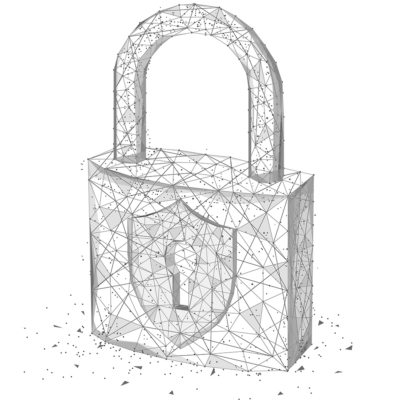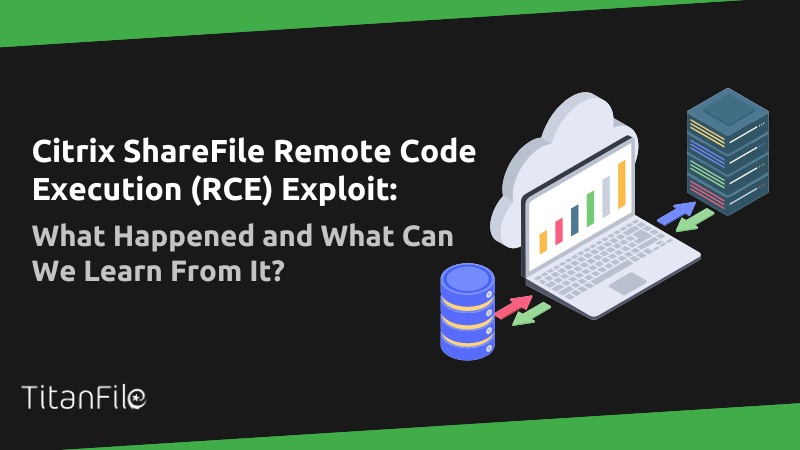INSIDE THIS ARTICLE
Summary
Citrix ShareFile is a cloud-based file sharing and collaboration application that provides users with the option to store files in their own data centres using “Storage Zone Connectors”. The Storage Zone Connectors software, called “Storage Zone Controllers” was discovered to be vulnerable to remote code execution (RCE) and exploits of this vulnerability have been detected in the wild.
TitanFile does not use Storage Zone Controllers or any of the technology stack in Storage Zone Controllers that lead to this vulnerability. TitanFile has secure software development processes in place to ensure its software is free from such vulnerabilities.
What is ShareFile?
ShareFile is a secure content collaboration, file sharing, and sync software owned by Citrix Systems Inc., a technology solutions provider based out of Raleigh, North Carolina.
The platform enables users to upload, store, organize, and collaborate on files across various devices and platforms, with the option to host data on premise via Storage Zone Controllers, or on ShareFile’s cloud-based servers.
About the ShareFile RCE Vulnerability
Timeline of Events
- On June 13, 2023, Citrix published a security bulletin on the Citrix Knowledge Center informing its customers of the critical vulnerability, tracked as CVE-2023-24489.
- On July 4, 2023, an in-depth analysis of vulnerability and how to exploit it was published by a security researcher with Assetnote on their blog.
- On August 16, 2023, the US Cybersecurity and Infrastructure Security Agency (CISA) added the vulnerability to its Known Exploited Vulnerabilities Catalog.
- On August 17, 2023, Citrix updated its security bulletin following reports of known exploits in the wild, advising its customers to shutdown affected versions of the software.
The CVE-2023-24489 vulnerability enables an unauthenticated user to upload arbitrary files to the server as well as full remote code execution (RCE), which is a type of security vulnerability that occurs when an attacker is able to execute arbitrary code or commands on a target system from a remote location, often over a network.
This type of vulnerability is considered highly critical because it enables an attacker to take control of the targeted system, potentially leading to unauthorized access, data breaches, and compromise of the system’s security.
As outlined in Assetnote’s report, the attack relies on several weaknesses in ShareFile’s implementation of Storage Zone Controllers. These weaknesses are vulnerabilities fall under the following OWASP Top 10 Categories:
Identification and Authentication Failure
Issues with verifying user identities can potentially lead to unauthorized access and activities, posing security concerns for systems and data.
Cryptographic Failures
Weaknesses in cryptographic mechanisms may expose vulnerabilities that compromise data protection, potentially leading to breaches and unauthorized disclosures.
Software and Data Integrity Failures
Software and Data Integrity Failures, as discussed in OWASP’s Top 10, encompass vulnerabilities that compromise the reliability of software and data, potentially leading to unauthorized alterations and breaches.
Among these concerns, path traversal vulnerabilities stand out, allowing unauthorized users to manipulate file paths and gain unauthorized access to sensitive information. This occurred in the recent Citrix ShareFile remote code execution exploit.
Employing rigorous input validation, implementing proper access controls, and conducting regular security assessments can effectively mitigate these risks and uphold the integrity of software and data.
Insecure Design
Insecure design involves architectural flaws that could inadvertently create vulnerabilities, potentially allowing unauthorized access and exploitation of systems, data, and functionalities.
In the ShareFile case, the design allowed for unapproved and unauthenticated file uploads through its Storage zone connectors.
To effectively bolster system resilience and thwart potential threats caused by insecure design, companies can introduce comprehensive threat modeling and security assessments during the design phase, coupled with adherence to established secure coding practices and frameworks.
How to protect against OWASP Top 10 Risks?

Below, we will explore some best practices and techniques to protect your applications from these risks.
1. Use secure software development methodology
Secure development methodology, also known as secure software development life cycle (SDLC), is an approach to software development that incorporates security principles and practices throughout the entire development process. It focuses on identifying and mitigating security risks from the early stages of development to the deployment and maintenance phases.
Adopting a secure development methodology can help prevent SQL injections and other security vulnerabilities through:
- Threat modeling
- Secure coding practices
- Secure code review and testing
- Security training and awareness
- Ongoing maintenance and updates.
2. Educate developers and test for OWASP Top 10
The OWASP Top 10 is a list of the most critical security risks faced by web applications. It is created and maintained by the Open Web Application Security Project (OWASP), a non-profit organization dedicated to improving software security. The OWASP Top 10 provides guidance on common vulnerabilities and helps developers prioritize security measures.
3. Enforce user input validation
User input validation is the process of verifying and sanitizing the data entered by users before it is processed or stored by an application. This means that the input data format, type, duration and range needs to be validated in order for them to meet the desired criteria.
4. Use strong authentication and session management
Implement a secure server-side session management system by generating complex, random session IDs after user login to prevent unauthorized access attempts. Store these IDs safely on the server, not in URLs, using stringent measures to avoid data leakage risks.
Additionally, strengthen security by invalidating generated session IDs in various situations—user logout, idle sessions, and a set time limit. This systematic approach effectively reduces potential unauthorized access and data exposure, bolstering data protection measures.
5. Perform static code analysis
Static code analysis is a technique used in software development to examine the source code of a program without executing it. It involves analyzing the codebase for potential issues, errors, or vulnerabilities, with the goal of improving code quality, identifying bugs, and enhancing security.
By utilizing static code analysis tools, you can detect many potential vulnerabilities and patch them before they are exploited.
6. Undergo routine vulnerability testing
Vulnerability testing, also known as vulnerability assessment or security testing, is a process of evaluating software systems or applications to identify security weaknesses, vulnerabilities, and potential attack vectors. It involves systematic testing techniques to identify and assess vulnerabilities in order to mitigate risks and improve the overall security of the system.
7. Undergo external penetration testing (pentesting)
External penetration testing, often referred to as a pentest, is a security assessment conducted by external security experts to identify vulnerabilities and assess the security posture of an organization’s network, systems, or applications. It involves simulating real-world attack scenarios to identify potential weaknesses and provide recommendations for improving the overall security.
Does the ShareFile Exploit Impact TitanFile?
TitanFile does not use ShareFile and has secure software development processes in place to ensure that its software is free from the identification and authentication failures, cryptographic failures, software and data integrity failures, and insecure design vulnerabilities that were found present in the ShareFile software.
Furthermore, TitanFile prioritizes security by subjecting its system to annual external penetration testing conducted by a competent third party. This comprehensive pentest includes both manual and automated testing, specifically targeting the OWASP Top 10 vulnerabilities. This rigorous testing helps ensure that TitanFile maintains a strong security posture and remains resilient against potential vulnerabilities and exploits.
Learn more about TitanFile’s security infrastructure.
References and Resources:
- Citrix Support Article. “ShareFile StorageZones Controller Security Update for CVE-2023-24489.” Accessed on August 17, 2023. Available at: https://support.citrix.com/article/CTX559517
- National Vulnerability Database. “CVE-2023-24489.” Accessed on August 17, 2023. Available at: https://nvd.nist.gov/vuln/detail/CVE-2023-24489
- OWASP Attack Knowledge Base. “Path Traversal.” Accessed on August 17, 2023. Available at: https://owasp.org/www-community/attacks/Path_Traversal
- Assetnote Blog Post. “Citrix ShareFile RCE: A Security Analysis.” Accessed on August 17, 2023. Available at: https://blog.assetnote.io/2023/07/04/citrix-sharefile-rce/
- OWASP Top Ten 2021. “A07-Identification and Authentication Failures.” Accessed on August 17, 2023. Available at: https://owasp.org/Top10/A07_2021-Identification_and_Authentication_Failures/
- OWASP Top Ten 2021. “A08-Software and Data Integrity Failures.” Accessed on August 17, 2023. Available at: https://owasp.org/Top10/A08_2021-Software_and_Data_Integrity_Failures/
- OWASP Top Ten 2021. “A02-Cryptographic Failures.” Accessed on August 17, 2023. Available at: https://owasp.org/Top10/A02_2021-Cryptographic_Failures/

